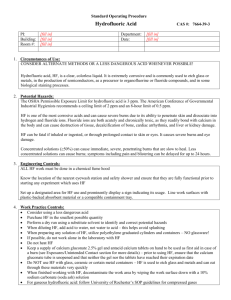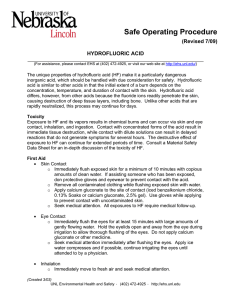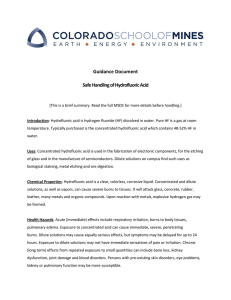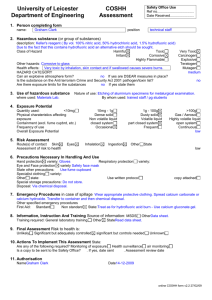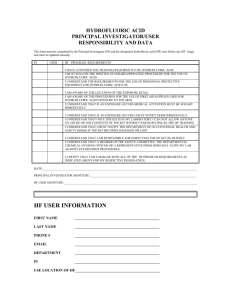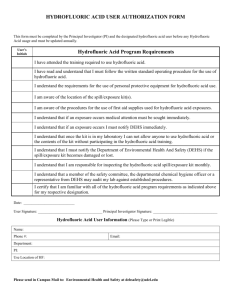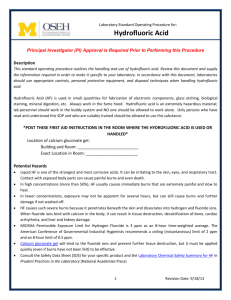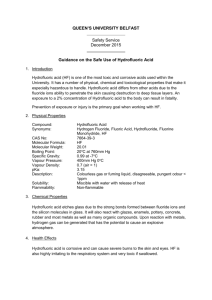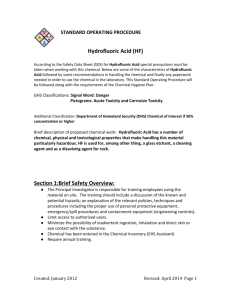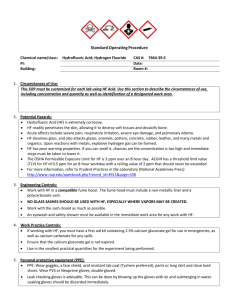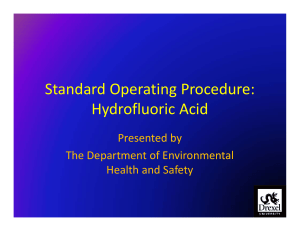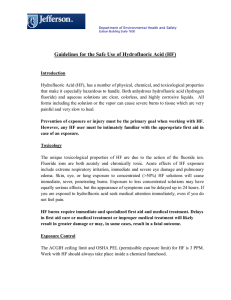Hydrofluoric Acid Fact Sheet - the Department of Environmental
advertisement
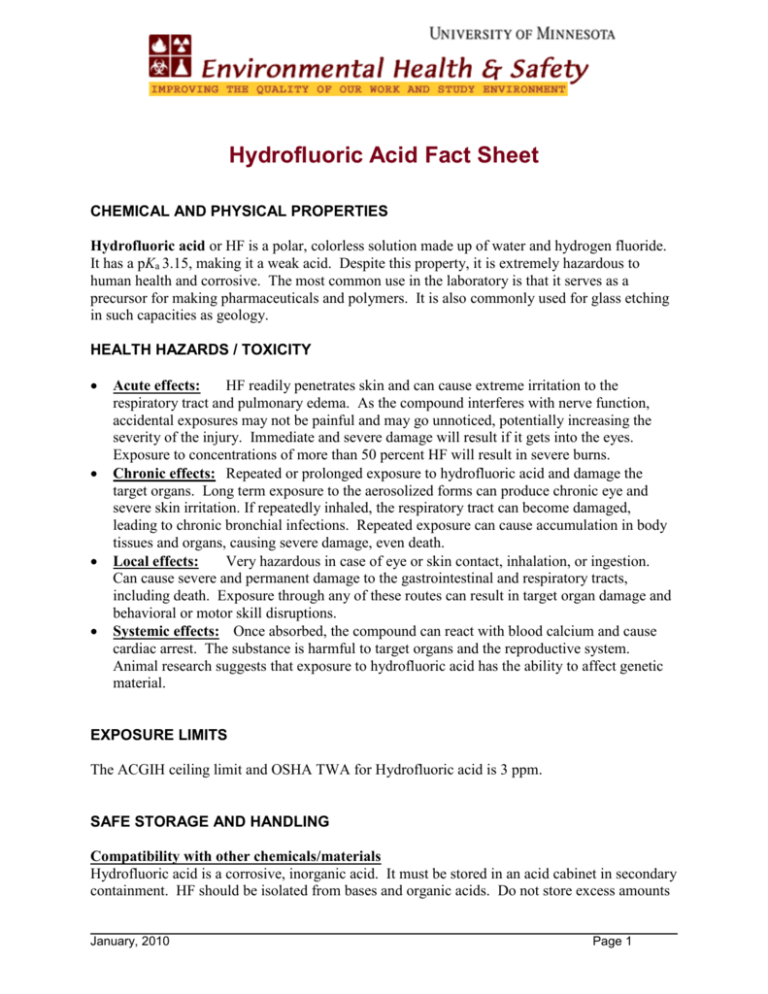
Hydrofluoric Acid Fact Sheet CHEMICAL AND PHYSICAL PROPERTIES Hydrofluoric acid or HF is a polar, colorless solution made up of water and hydrogen fluoride. It has a pKa 3.15, making it a weak acid. Despite this property, it is extremely hazardous to human health and corrosive. The most common use in the laboratory is that it serves as a precursor for making pharmaceuticals and polymers. It is also commonly used for glass etching in such capacities as geology. HEALTH HAZARDS / TOXICITY Acute effects: HF readily penetrates skin and can cause extreme irritation to the respiratory tract and pulmonary edema. As the compound interferes with nerve function, accidental exposures may not be painful and may go unnoticed, potentially increasing the severity of the injury. Immediate and severe damage will result if it gets into the eyes. Exposure to concentrations of more than 50 percent HF will result in severe burns. Chronic effects: Repeated or prolonged exposure to hydrofluoric acid and damage the target organs. Long term exposure to the aerosolized forms can produce chronic eye and severe skin irritation. If repeatedly inhaled, the respiratory tract can become damaged, leading to chronic bronchial infections. Repeated exposure can cause accumulation in body tissues and organs, causing severe damage, even death. Local effects: Very hazardous in case of eye or skin contact, inhalation, or ingestion. Can cause severe and permanent damage to the gastrointestinal and respiratory tracts, including death. Exposure through any of these routes can result in target organ damage and behavioral or motor skill disruptions. Systemic effects: Once absorbed, the compound can react with blood calcium and cause cardiac arrest. The substance is harmful to target organs and the reproductive system. Animal research suggests that exposure to hydrofluoric acid has the ability to affect genetic material. EXPOSURE LIMITS The ACGIH ceiling limit and OSHA TWA for Hydrofluoric acid is 3 ppm. SAFE STORAGE AND HANDLING Compatibility with other chemicals/materials Hydrofluoric acid is a corrosive, inorganic acid. It must be stored in an acid cabinet in secondary containment. HF should be isolated from bases and organic acids. Do not store excess amounts January, 2010 Page 1 Department of Environmental Health and Safety – Hydrofluoric Acid Fact Sheet of HF acid in the laboratory. Keep only the amount that is experimentally necessary. HF that is no longer in use must be manifested through the University’s Hazardous Waste Program. Safe Use of Hydrofluoric Acid Before conducting any experiment using HF, you must have fresh antidote gel available in your lab. The gel for HF burns contains 2.5% calcium gluconate and can be purchased from most of the well known chemical supply companies. In addition, it is available at the pharmacy in Boynton Health Services. Pay attention to the printed shelf life for calcium gluconate gel which may vary between 3 and 12 months. Wear personal protective equipment (PPE) when handling any amount of HF including: nitrile or neoprene gloves, goggles, face shield, and a lab coat. HF should always be used in a chemical fume hood. As HF can dissolve glass, collect any HF waste or unused HF in a polyethylene or Teflon container. HF waste should be manifested through the University’s Hazardous Waste Program. EMERGENCY AND SPILL INFORMATION Inhalation: Seek immediate medical attention – dial 911. This type of exposure may require treatment with a specialized nebulizer of oxygen and 2.5% calcium gluconate. Eyes: Seek medical attention immediately. Check for and remove any contact lenses. Rinse eyes for 15 minutes in the eyewash. Skin Contact: Seek medical attention – dial 911. If the chemical contacts the clothed portion of the body, remove the contaminated clothes as quickly as possible. Bag contaminated clothing for appropriate disposal (see Waste Management Procedures). If the chemical contacts exposed skin, gently and thoroughly wash with running water and non-abrasive soap. Be particularly careful to clean folds, crevices, creases and mucous membranes. Using appropriate protective gloves, apply a generous amount of anecdotal calcium gluconate gel to the exposed area and continue applying until medical help arrives. Accidental ingestion: Do not induce vomiting. Immediately dial 911. Accidental injection: Seek medical attention, immediately. Spill Information: In the event of a large Hydrofluoric acid spill (more than 50 ml), contact DEHS immediately at 612-626-6002. Do not attempt to clean up the spill yourself. If small amounts (50 ml or less) of HF or HF solution should spill, prevent any liquid from entering the sewer. Apply absorbent pads for larger amounts of liquid and, using appropriate PPE, carefully scoop wetted absorbent material into a container to be manifested as hazardous waste. January, 2010 Page 2 Department of Environmental Health and Safety – Hydrofluoric Acid Fact Sheet CHEMICAL WASTE AND CLEAN-UP PROCEDURES Dispose of both excess HF and HF solutions as hazardous waste. For more information: http://www.dehs.umn.edu/hazwaste_chemwaste_umn_cwmgbk_sec4.htm ADDITIONAL INFORMATION For general information regarding the safe use of Hydrofluoric Acid, please contact DEHS at (612) 626-6002. If you have any concerns regarding the stability or testing of a chemical, contact the Hazardous Waste Program at (612) 624-1604. REFERENCES http://www.des.umd.edu/ls/sop/HydrofluoricAcid.pdf http://www.ndsu.nodak.edu/ndsu/police_safety/safety/NDSU%20Safety%20Officer%20Homepa ge_files/HF/HF%20SOP.pdf http://www.sciencelab.com/xMSDS-Hydrofluoric_Acid_48_52_-9924294 HF Medical Treatment January, 2010 Page 3
